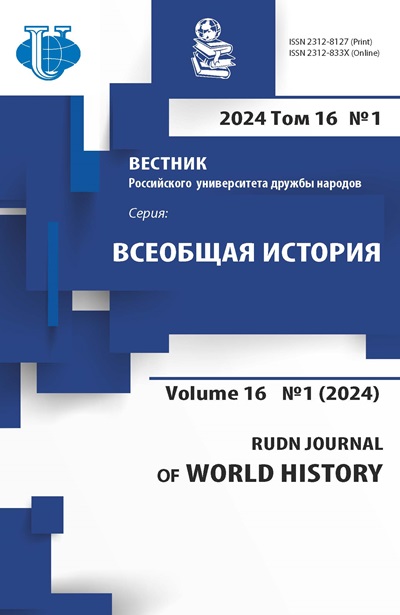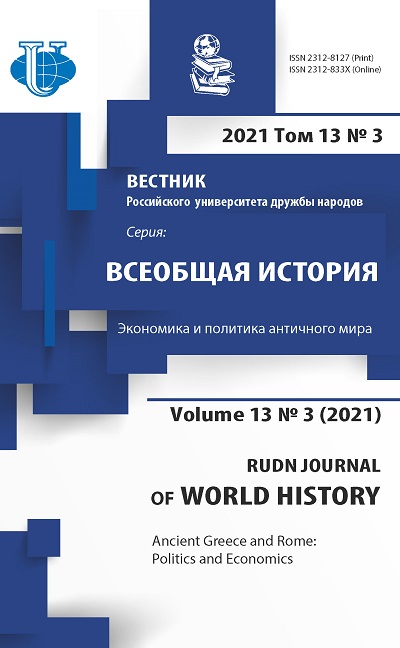Agricultural work on the sacred lands of Attica IV B.C. according to epigraphica
- Authors: Bulycheva E.V.1
-
Affiliations:
- Russian State University for the Humanities
- Issue: Vol 13, No 3 (2021): Ancient Greece and Rome: Politics and Economics
- Pages: 277-285
- Section: ECONOMY AND POLITICS OF ANCIENT GREECE
- URL: https://journals.rudn.ru/world-history/article/view/27322
- DOI: https://doi.org/10.22363/2312-8127-2021-13-3-277-285
Cite item
Full Text
Abstract
This article deals with the issue of carrying out agricultural work on the sacred lands of ancient Attica (Athens region) in the IV century B.C. The author relies on epigraphic sources, which are inscriptions on stone steles containing texts of lease agreements on sacred lands of the IV century B.C, and also uses information from ancient authors. The author also attracts scientific works of domestic and foreign authors devoted to the problem of agrarian relations in the ancient Greek polis. According to the author, the analysis and study of agricultural work on the territory of the sacred lands of Attica deserves a separate article, since the study of this issue makes it possible to more thoroughly consider agricultural relations in the Athenian polis of the IV century B.C, to present the meaning of sacred land ownership. In the first part of the article, the author analyzes the types and nature of agricultural work on sacred lands (temenos). The second part is devoted to the problem of responsibility of tenants and landlords for the performance of work on the territory of temenos. As a result, the author comes to certain conclusions. In the fourth century B.C, the sacred lands of Attica required special care after the end of the devastating actions of the Peloponnesian War. The temenos were at the disposal of the polis, with demes and religious unions as their landlords. The leasing of land made it possible to ensure the stable preservation of the land fund, to ensure the agricultural development of the temenos. Tenants (private individuals) were required to provide careful care for the leased land. At the same time, the author draws attention to the fact that in some cases the tenants were very well-known, wealthy citizens of the polis, for whom participation in the lease of sacred lands was a kind of liturgy. In such cases, it is difficult to determine who performed agricultural work on the leased land, most likely, it was special employees, whose work was paid by the tenant. At the same time, according to the epigraphica, there was no sublease.
Keywords
About the authors
Elena Vladimirovna Bulycheva
Russian State University for the Humanities
Author for correspondence.
Email: bulychevalena@yandex.ru
candidate of sciences (history), associate professor department of world history
6, Miusskaya square, Moscow, Russian Federation, 125993References
- Bulycheva EV. Ksenofont kak istorik I pisatel’v trudah antichnyh avtorov [Xenophont as a historian and writer in the works of ancient authors]. Pamyat’ I identichnost’ – II. Kto pishet istoriya: osobennosti formirovaniya istoricheskogo narrativa. Moscow: RGGU Publishing House, 2020; P. 11–19. (In Russ.).
- Bulycheva EV. Drevnjya Attika v kontse V–IV vv. do n.e. Rasporyazhenie obchestvennoi zemlyeiy v polise [Ancient Attica at the end of V – IV centuries B.C. the Disposal of public land in the policy]. Moscow: RGGU Publishing House, 2020. (In Russ.).
- Inscriptiones Graecae. Consiluo et avetoritate academiae li terarum Borussica. Vol. II–III. Berlin: Berolini, 1924.
- Pleket HW. Epigraphica. Texts on Economic History of the Greek World. Leiden, 1964.
- Andreev VN. Agrarnye otnosheniya v Attike V–IV vv. do n.e. [Agrarian relations in Attica V–IV centuries B.C.], Antichnaya Gretsiya. Moscow: Nauka Publishing House, 1983; P. 247–327. (In Russ.).
- Gluskina LM. Problemy socialel’no-ekonomicheskoy istorii Afin IV v do n.e. [Problems of the socio-economic history of Athens in the IV century B.C.]. Leningrad: Nauka Publishing House, 1975. (In Russ.).
- Finley MI. Studies in land and credit in ancient Athens 500–200 B.C. New Brunswick: New Jersey, 1952.
- Osborne R. Social and economic implications of the leasing of land and property in classical and hellenistic Greece. Chiron. 1988;(18):279–323.
- Bulycheva EV. Prava i obyazonnosti arendodateley svyachennoi zemli v Attike (IV v. do n. e.) [Rights and obligations of the lessors of the sacred land in Attica (IV century B.C]. Vestnik RUDN. Serija. Vseobchaya Istoriya. 2017;9(4):301–310. (In Russ.).













